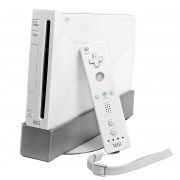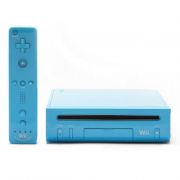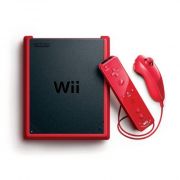Wii:Buying Guide: Difference between revisions
(Created page, listed all 3 models and differences, added incompatible games list) |
WiiExpertise (talk | contribs) (Added some sections, fixed some incorrect info.) |
||
| Line 6: | Line 6: | ||
This model was the first to launch. It was designed to stand up on the included stand, with all the buttons being labelled to be read when the console was vertical. On the top side, there were flaps that covered four GameCube controller ports, as well as two GameCube memory card slots. This model was capable of playing GameCube games natively using all compatible accessories that could fit into the included slots. | This model was the first to launch. It was designed to stand up on the included stand, with all the buttons being labelled to be read when the console was vertical. On the top side, there were flaps that covered four GameCube controller ports, as well as two GameCube memory card slots. This model was capable of playing GameCube games natively using all compatible accessories that could fit into the included slots. | ||
Each console has two USB ports in the back, as well as a 12V AC in, sensor bar | Each console has two USB ports in the back, as well as a 12V AC in, sensor bar power port, and an AV out port. On the front side, there are three buttons visible: the power button, reset button, and disc eject button. There is also a flap on the front side of the console. Opening this reveals a controller sync button and an SD card slot, with support for up to 32 GB officially (although larger sizes have been unofficially confirmed to work as well) on later versions of the system software. This side also has the disc drive, which uses a slot-loading mechanism. | ||
Three colors were made of this model: white, black, and red. The white model was the only one available at launch, with the black and red models releasing later. | Three colors were made of this model: white, black, and red. The white model was the only one available at launch, with the black and red models releasing later. | ||
| Line 12: | Line 12: | ||
==Family Edition - RVL-101== | ==Family Edition - RVL-101== | ||
[[File:Wii-Family-Edition-Blue.jpg|180px|thumb|right|RVL-101 Wii in blue, laid horizontally]] | [[File:Wii-Family-Edition-Blue.jpg|180px|thumb|right|RVL-101 Wii in blue, laid horizontally]] | ||
The second model to launch, around 2011. This model was designed to be placed horizontally, with the button labels reflecting this change. It has almost all of the same input and output ports, including USB and SD. However, the difference is that this model entirely removed all GameCube controller and memory card ports, as well as the ability to play GameCube | The second model to launch, around 2011. This model was designed to be placed horizontally, with the button labels reflecting this change. It has almost all of the same input and output ports, including USB and SD. However, the difference is that this model entirely removed all GameCube controller and memory card ports, as well as the ability to play GameCube discs. Doing so caused either full or partial incompatibility with certain Wii games that utilized the GameCube controller ports. However, the software on the RVL-101 is still capable of playing GameCube games, allowing homebrew GameCube loaders such as Nintendont to still work on these Wiis. Additionally, the solder pads for the GameCube controller and memory card ports are still present on the board, meaning the ports can be soldered back on and used normally. | ||
List pulled from [https://en-americas-support.nintendo.com/app/answers/detail/a_id/2650/~/what-is-the-difference-between-the-models-of-wii-consoles%3F Nintendo's Wii model differences list] | List pulled from [https://en-americas-support.nintendo.com/app/answers/detail/a_id/2650/~/what-is-the-difference-between-the-models-of-wii-consoles%3F Nintendo's Wii model differences list] | ||
| Line 46: | Line 46: | ||
|} | |} | ||
This model was produced in | This model was produced in three colors: white, black, and blue. Each had a corresponding Wii Remote and Nunchuck of the same color. | ||
==Wii Mini - RVL-201== | ==Wii Mini - RVL-201== | ||
[[File:Wii-Mini-Controllers.jpeg|180px|thumb|RVL-201 Wii Mini console with bundled red controller]] | [[File:Wii-Mini-Controllers.jpeg|180px|thumb|RVL-201 Wii Mini console with bundled red controller]] | ||
The last revision of the Wii, initially released exclusively in Canada in 2012, and later releasing in the United States and Europe. This console featured a top loader disc drive, as well as power and | The last revision of the Wii, initially released exclusively in Canada in 2012, and later releasing in the United States and Europe. This console featured a top loader disc drive as opposed to the slot loader of the previous 2 revisions, as well as power and eject buttons next to the drive, more similar to those of the GameCube than to its previous versions. It also only had one USB slot, and removed the SD card slot featured in previous models. The reset button was also removed. | ||
In terms of connectivity, this model removed the capacity to connect to Wi-Fi. This means that any game with an online component would be partially incompatible with this console, typically removing things such as online multiplayer. Because of the lack of Wi-Fi, the console cannot be updated | The ports on the back of the console remained largely the same besides the removal of one USB port, with one exception: while previous models were capable of outputting composite video up to 480i or component video up to 480p, the latter was removed from the Wii Mini, meaning only composite cables can be used, and the Wii Mini will only output a maximum resolution of 480i. | ||
In terms of connectivity, this model removed the capacity to connect to Wi-Fi. This means that any game with an online component would be partially incompatible with this console, typically removing things such as online multiplayer. Because of the lack of Wi-Fi, the console cannot be updated. Even if a disc update is attempted, the software version numbers of the Wii Mini have been made higher than all existing official Wii software, meaning no updates will be found. | |||
This version of the console is also incompatible with all the games listed in the RVL-101 model portion, due to a lack of GameCube ports. | This version of the console is also incompatible with all the games listed in the RVL-101 model portion, due to a lack of GameCube ports. | ||
Although none of the homebrew exploits that existed for previous revisions are compatible with the Wii Mini due to the removal of the features they relied on, the Bluebomb exploit is compatible with the Wii Mini, and it is the only way to softmod a stock Wii Mini. | |||
While the Wii Mini is heavily stripped down compared to the RVL-001 and RVL-101 models, the motherboard still contains the test points for the SD card slot, GameCube ports, and the reset button. The board is also capable of all the other features that were stripped from this revision. With some soldering work (both easy and difficult) and some slight software changes, it is possible to restore all of the missing features, including component video, Wi-Fi, the SD card slot, and more. | |||
Revision as of 06:06, 14 January 2022
The Wii was a very successful console for Nintendo, and following their usual pattern, it had a few redesigns and models over the years. All Wii models follow the model name convention of RVL-X01. RVL stand for Revolution, which was the internal name for the Wii during development, while the X is a number in order of release, either 0, 1, or 2.
Launch Model - RVL-001
This model was the first to launch. It was designed to stand up on the included stand, with all the buttons being labelled to be read when the console was vertical. On the top side, there were flaps that covered four GameCube controller ports, as well as two GameCube memory card slots. This model was capable of playing GameCube games natively using all compatible accessories that could fit into the included slots.
Each console has two USB ports in the back, as well as a 12V AC in, sensor bar power port, and an AV out port. On the front side, there are three buttons visible: the power button, reset button, and disc eject button. There is also a flap on the front side of the console. Opening this reveals a controller sync button and an SD card slot, with support for up to 32 GB officially (although larger sizes have been unofficially confirmed to work as well) on later versions of the system software. This side also has the disc drive, which uses a slot-loading mechanism.
Three colors were made of this model: white, black, and red. The white model was the only one available at launch, with the black and red models releasing later.
Family Edition - RVL-101
The second model to launch, around 2011. This model was designed to be placed horizontally, with the button labels reflecting this change. It has almost all of the same input and output ports, including USB and SD. However, the difference is that this model entirely removed all GameCube controller and memory card ports, as well as the ability to play GameCube discs. Doing so caused either full or partial incompatibility with certain Wii games that utilized the GameCube controller ports. However, the software on the RVL-101 is still capable of playing GameCube games, allowing homebrew GameCube loaders such as Nintendont to still work on these Wiis. Additionally, the solder pads for the GameCube controller and memory card ports are still present on the board, meaning the ports can be soldered back on and used normally.
List pulled from Nintendo's Wii model differences list
| Game Name | Full or partial |
|---|---|
| Active Life: Explorer | Full |
| Active Life: Extreme Challenge | Full |
| Active Life: Magical Carnival | Full |
| Active Life: Outdoor Challenge | Full |
| Dance Dance Revolution | Partial |
| DanceDanceRevolution II | Partial |
| Dance Dance Revolution: Disney Grooves | Partial |
| DanceDanceRevolution Hottest Party | Partial |
| DanceDanceRevolution Hottest Party 2 | Partial |
| DanceDanceRevolution Hottest Party 3 | Partial |
| Ultimate Party Challenge | Full |
| Walk It Out | Partial |
This model was produced in three colors: white, black, and blue. Each had a corresponding Wii Remote and Nunchuck of the same color.
Wii Mini - RVL-201
The last revision of the Wii, initially released exclusively in Canada in 2012, and later releasing in the United States and Europe. This console featured a top loader disc drive as opposed to the slot loader of the previous 2 revisions, as well as power and eject buttons next to the drive, more similar to those of the GameCube than to its previous versions. It also only had one USB slot, and removed the SD card slot featured in previous models. The reset button was also removed.
The ports on the back of the console remained largely the same besides the removal of one USB port, with one exception: while previous models were capable of outputting composite video up to 480i or component video up to 480p, the latter was removed from the Wii Mini, meaning only composite cables can be used, and the Wii Mini will only output a maximum resolution of 480i.
In terms of connectivity, this model removed the capacity to connect to Wi-Fi. This means that any game with an online component would be partially incompatible with this console, typically removing things such as online multiplayer. Because of the lack of Wi-Fi, the console cannot be updated. Even if a disc update is attempted, the software version numbers of the Wii Mini have been made higher than all existing official Wii software, meaning no updates will be found.
This version of the console is also incompatible with all the games listed in the RVL-101 model portion, due to a lack of GameCube ports.
Although none of the homebrew exploits that existed for previous revisions are compatible with the Wii Mini due to the removal of the features they relied on, the Bluebomb exploit is compatible with the Wii Mini, and it is the only way to softmod a stock Wii Mini.
While the Wii Mini is heavily stripped down compared to the RVL-001 and RVL-101 models, the motherboard still contains the test points for the SD card slot, GameCube ports, and the reset button. The board is also capable of all the other features that were stripped from this revision. With some soldering work (both easy and difficult) and some slight software changes, it is possible to restore all of the missing features, including component video, Wi-Fi, the SD card slot, and more.


